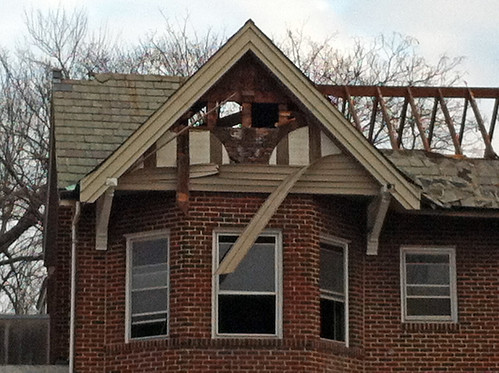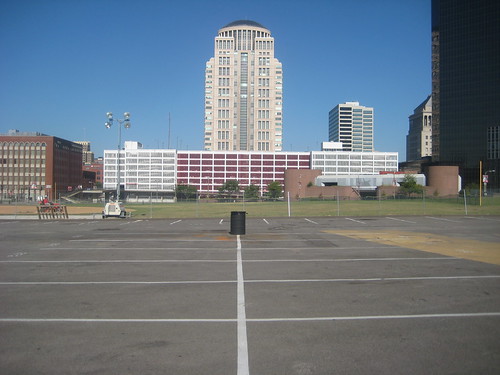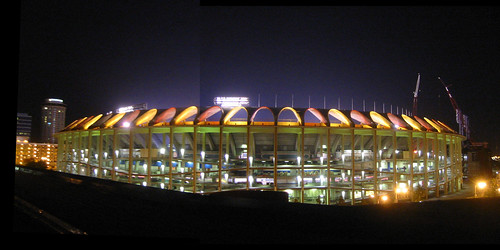 Demolitions are underway for phase 1 of the Loop Living development at Delmar and Eastgate.
Demolitions are underway for phase 1 of the Loop Living development at Delmar and Eastgate.
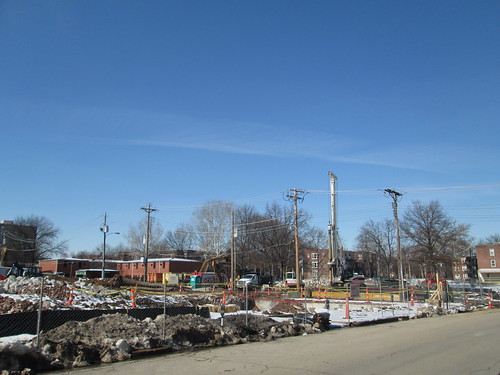 The buildings at 609 Eastgate and 6236 Enright are gone as well as several townhome blocks of the University Terrace Apartments.
The buildings at 609 Eastgate and 6236 Enright are gone as well as several townhome blocks of the University Terrace Apartments.
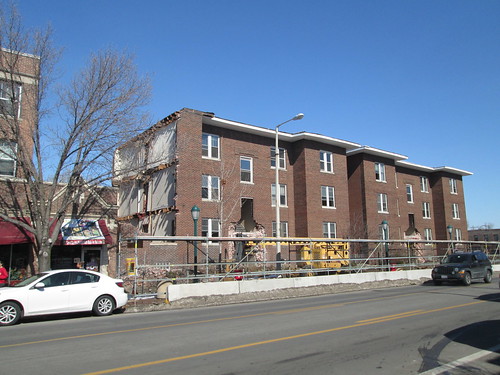 On Delmar the six family building at 6263 is slowly coming down.
On Delmar the six family building at 6263 is slowly coming down.
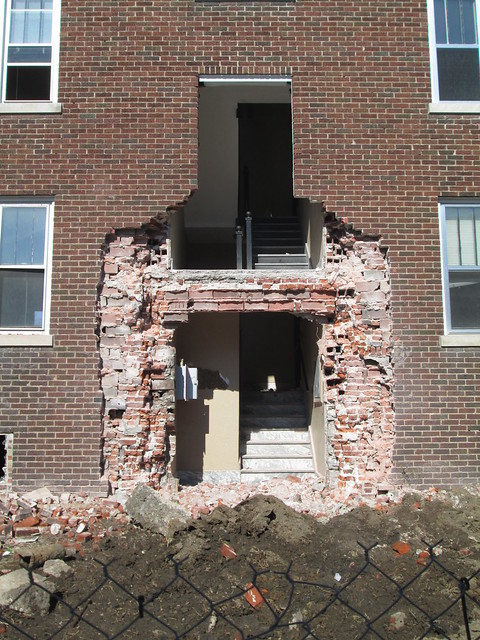 Fortunately it appears that the decorative terra cotta entrance surrounds of both buildings have been salvaged.
Fortunately it appears that the decorative terra cotta entrance surrounds of both buildings have been salvaged.
 Anticipating the new multi-story construction, protective scaffold has been erected along the entire frontage to keep a pedestrian path along Delmar open.
Anticipating the new multi-story construction, protective scaffold has been erected along the entire frontage to keep a pedestrian path along Delmar open.
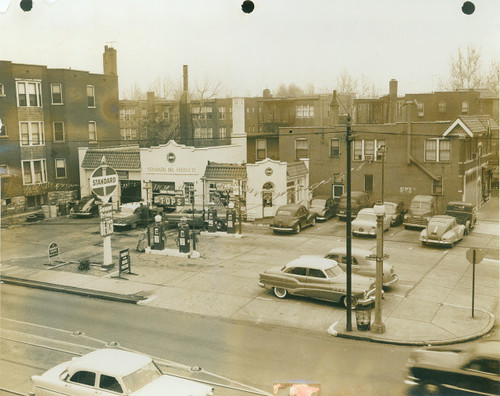 Sifting through the pages of the Delmar Loop Photograph Project available online through Missouri Digital Heritage, I came across a few photos of the Standard service station that preceded the building that had been occupied for many years by Meineke. The building was almost identical to the station at Newstead & Laclede that according to City property records was built in 1933. What isn't obvious in the photo above is that when the older station was replaced the gas station site was enlarged.
Sifting through the pages of the Delmar Loop Photograph Project available online through Missouri Digital Heritage, I came across a few photos of the Standard service station that preceded the building that had been occupied for many years by Meineke. The building was almost identical to the station at Newstead & Laclede that according to City property records was built in 1933. What isn't obvious in the photo above is that when the older station was replaced the gas station site was enlarged.
 A narrow six family apartment building at 6251 Delmar, at the right in the photo above, was demolished when the newer station was built sometime around 1967.
A narrow six family apartment building at 6251 Delmar, at the right in the photo above, was demolished when the newer station was built sometime around 1967.
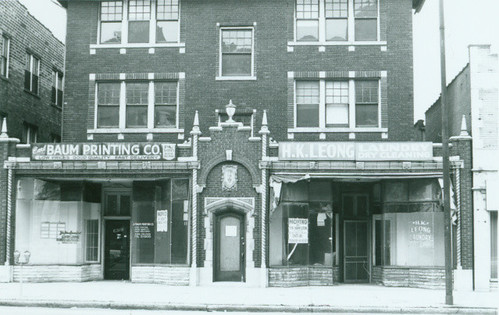 Around the same time several buildings west, two buildings were demolished to create a surface parking lot directly across from the entrance to the Tivoli Theater. The east building at 6319 Delmar appears to have had it's storefronts added later as was the case with many buildings along this row.
Around the same time several buildings west, two buildings were demolished to create a surface parking lot directly across from the entrance to the Tivoli Theater. The east building at 6319 Delmar appears to have had it's storefronts added later as was the case with many buildings along this row.
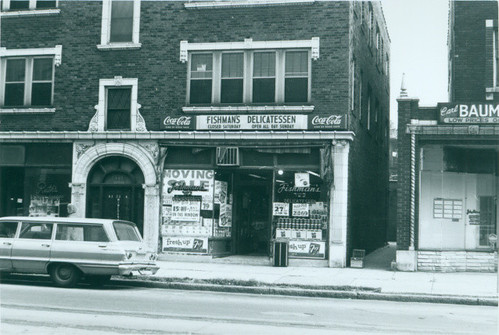 The building at 6321 Delmar had storefronts integral to the construction of the building.
The building at 6321 Delmar had storefronts integral to the construction of the building.
 By 1967, when this photo montage was created, the site had been cleared. The parking lot, which would remain for three decades, was part of a larger overall urban renewal plan enacted in the Loop in the late 1960's. This site is now occupied by the University City public parking garage, which is also home to Good Works furniture, constructed in 1998.
By 1967, when this photo montage was created, the site had been cleared. The parking lot, which would remain for three decades, was part of a larger overall urban renewal plan enacted in the Loop in the late 1960's. This site is now occupied by the University City public parking garage, which is also home to Good Works furniture, constructed in 1998.
 A matching lot had been created across the street between the Tivoli and the one story building that housed Streetside Records for many years. Both lots had masonry screen walls along the sidewalk punctuated by terra cotta lions that had been salvaged presumably from a demolished building. This past Friday evening I noticed that the wall is gone and the lot appears to be under re-construction. According to the Green Practices Commission page of U-City's website, the lot will be re-paved with permeable pavement. No word as to whether the wall will be rebuilt.
A matching lot had been created across the street between the Tivoli and the one story building that housed Streetside Records for many years. Both lots had masonry screen walls along the sidewalk punctuated by terra cotta lions that had been salvaged presumably from a demolished building. This past Friday evening I noticed that the wall is gone and the lot appears to be under re-construction. According to the Green Practices Commission page of U-City's website, the lot will be re-paved with permeable pavement. No word as to whether the wall will be rebuilt.
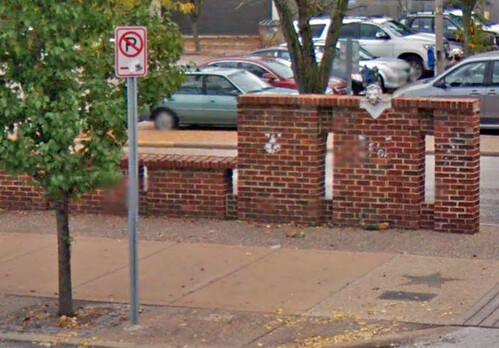
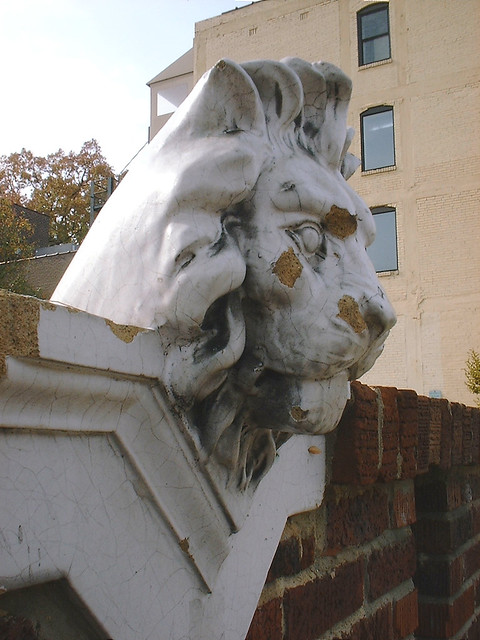 A closeup of one of the now missing lions by Flickr member MBK.
A closeup of one of the now missing lions by Flickr member MBK.
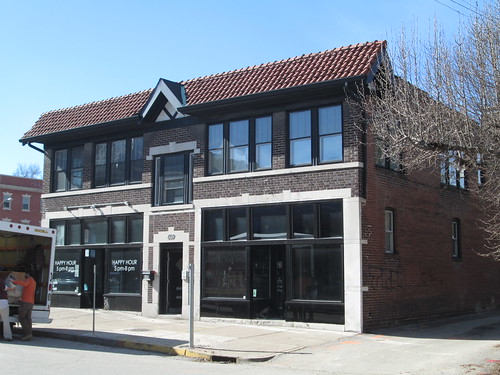 Demolition are beginning this week in the Loop to make way for Washington University's new Loop Living development. Those coming down include four buildings dating from the early 1920's near the intersection of Delmar & Eastgate. Of these, probably most significant of is 609 Eastgate, which until recently housed a series of sushi restaurants and two apartments above. With its simple but elegant stone trim and decorative red tile roof, this building epitomizes the typology of structures that make up commercial districts throughout the City and inner suburbs.
Demolition are beginning this week in the Loop to make way for Washington University's new Loop Living development. Those coming down include four buildings dating from the early 1920's near the intersection of Delmar & Eastgate. Of these, probably most significant of is 609 Eastgate, which until recently housed a series of sushi restaurants and two apartments above. With its simple but elegant stone trim and decorative red tile roof, this building epitomizes the typology of structures that make up commercial districts throughout the City and inner suburbs.
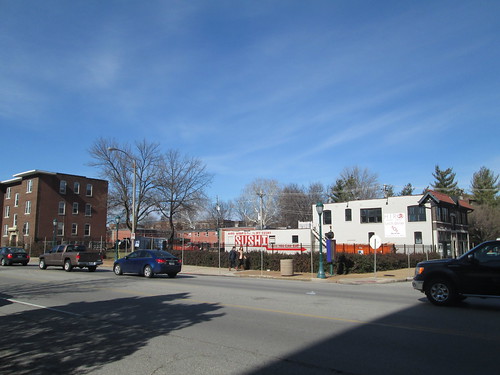 At the corner, just south of the 609 building, is a lot that with 150 of frontage on Delmar has been vacant for several years since an abandoned Meineke Muffler shop was cleared.
At the corner, just south of the 609 building, is a lot that with 150 of frontage on Delmar has been vacant for several years since an abandoned Meineke Muffler shop was cleared.
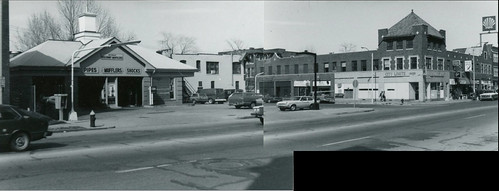 The Meineke building, originally a Standard gas station was built in 1965. This photo from a 1983 architectural survey of the Parkview Gardens neighborhood illustrates the gap created in the Delmar streetscape by this automotive user. Across Eastgate, the storefronts of the corner space that most recently housed the Delmar Lounge have been restored since this photo. Coming soon to this space will be the Mission Taco Joint. a new tacoria that will serve duck tacos among other specialties.
The Meineke building, originally a Standard gas station was built in 1965. This photo from a 1983 architectural survey of the Parkview Gardens neighborhood illustrates the gap created in the Delmar streetscape by this automotive user. Across Eastgate, the storefronts of the corner space that most recently housed the Delmar Lounge have been restored since this photo. Coming soon to this space will be the Mission Taco Joint. a new tacoria that will serve duck tacos among other specialties.
 The Loop Living development will feature two 4-5 story buildings fronting on Delmar with continuous retail on the first floor and student apartments above. The first phase will include the two buildings on Delmar and two on Enright. A pedestrian walkway will connect Delmar and Enright between the buildings. Note that the courtyard shown in building 1A above will be at the 2nd floor with retail space continuous fronting Delmar below. The design of the buildings by William Rawn Associates, Architects of Boston with associate architect Tao + Lee Associates, Inc. of St. Louis, especially along Delmar, is a refreshing departure from the traditional styles used in newer student housing on WU's main campus and South 40.
The Loop Living development will feature two 4-5 story buildings fronting on Delmar with continuous retail on the first floor and student apartments above. The first phase will include the two buildings on Delmar and two on Enright. A pedestrian walkway will connect Delmar and Enright between the buildings. Note that the courtyard shown in building 1A above will be at the 2nd floor with retail space continuous fronting Delmar below. The design of the buildings by William Rawn Associates, Architects of Boston with associate architect Tao + Lee Associates, Inc. of St. Louis, especially along Delmar, is a refreshing departure from the traditional styles used in newer student housing on WU's main campus and South 40.
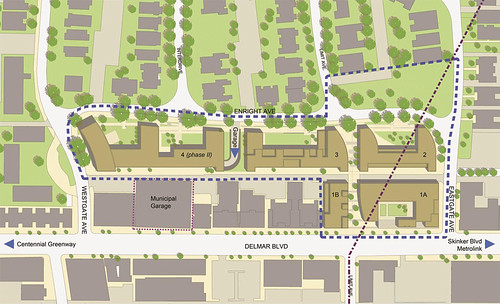 The 609 Eastgate building is located at the far northwest corner of the Skinker DeBaliviere-Catlin Tract-Parkview Historic District. Washington University presented the Loop Living proposal to the Historic District Committee, of which I am a member, last year. While we were of course not thrilled with the idea of losing the 609 building (the other buildings are out of our jurisdiction), we felt that the overall improvement that this development will bring to the Loop and to the vacant Meineke lot that is in the historic district outweigh the loss of the building. The new retail spaces on Delmar that will be part a major component of this development along with the recently added one-story retail building that houses Dick Blick will go a long way toward bringing together the west Loop and more recently developed east Loop.
The 609 Eastgate building is located at the far northwest corner of the Skinker DeBaliviere-Catlin Tract-Parkview Historic District. Washington University presented the Loop Living proposal to the Historic District Committee, of which I am a member, last year. While we were of course not thrilled with the idea of losing the 609 building (the other buildings are out of our jurisdiction), we felt that the overall improvement that this development will bring to the Loop and to the vacant Meineke lot that is in the historic district outweigh the loss of the building. The new retail spaces on Delmar that will be part a major component of this development along with the recently added one-story retail building that houses Dick Blick will go a long way toward bringing together the west Loop and more recently developed east Loop.
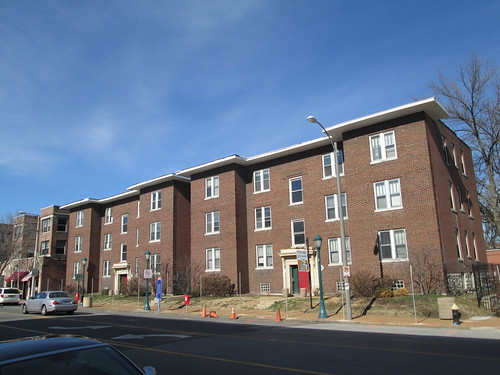 Immediatly west of the Meineke lot are two 6-family apartment buildings that will also come down. These buildings at 6255 and 6263 Delmar were built by John M. Cook for developer Victor E. Rhodes in 1921. Rhodes and son-in-law Cook built about 15 buildings in the Parkview Gardens neighborhood. The deep overhangs featured exposed rafters that are now hidden by metal or vinyl soffiting and were originally capped with a tile coping at the front edges.
Immediatly west of the Meineke lot are two 6-family apartment buildings that will also come down. These buildings at 6255 and 6263 Delmar were built by John M. Cook for developer Victor E. Rhodes in 1921. Rhodes and son-in-law Cook built about 15 buildings in the Parkview Gardens neighborhood. The deep overhangs featured exposed rafters that are now hidden by metal or vinyl soffiting and were originally capped with a tile coping at the front edges.
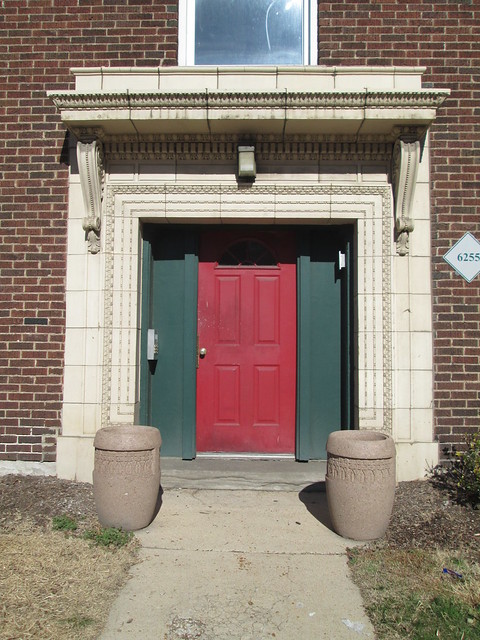 The highly decorative terra cotta entrances seem almost out of place on these buildings which are almost devoid of ornamentation. I would have expected to see an entrance with either a small tile roof in the arts & crafts style or an even simpler entrance with pain stone banding of no ornament at all as is typified my many of the buildings in the blocks north.
The highly decorative terra cotta entrances seem almost out of place on these buildings which are almost devoid of ornamentation. I would have expected to see an entrance with either a small tile roof in the arts & crafts style or an even simpler entrance with pain stone banding of no ornament at all as is typified my many of the buildings in the blocks north.
 The buildings at 6255 & 6263 Delmar have twins two buildings to the west at 6301-05 and 6307-09 Delmar also built in 1921. The storefronts of the building above were added to the building in 1935 in a streamlined style that has been altered. The apartment entrance was moved to the west side.
The buildings at 6255 & 6263 Delmar have twins two buildings to the west at 6301-05 and 6307-09 Delmar also built in 1921. The storefronts of the building above were added to the building in 1935 in a streamlined style that has been altered. The apartment entrance was moved to the west side.
The Jacobethan style storefronts at the building below with extended central apartment entrance were added in 1928 by architect Norman B. Howard. Unfortunately since the 1983 photo from the architectural survey, the broad overhangs on this building have been hacked back to within a foot of the building face and leaving the edge of the roofing drooping over the edges. Norman B. Howard also designed a storefront addition in the same Jacobethan style connecting two 1919 apartment buildings at 6265-77 Delmar.
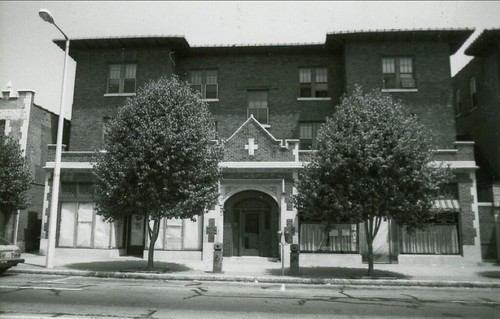 Unlike storefront additions to homes in other parts of St. Louis where the original setback was greater, these are not simply additions to the front of the buildings. Instead, they were complex transformations carving out the spaces of the ground floor apartments and adding structural capacity to span the width of the stores. The floor line of the former apartments were also lowered to sidewalk level at least in the front portions by filling in the portion of the basements extending below grade. In the late 1920's though retail trade in the Loop was booming enough to make such expensive transformations a lucrative investment. Please note that none of these buildings with retail spaces west of 6255 and 6263 Delmar are part of the new development.
Unlike storefront additions to homes in other parts of St. Louis where the original setback was greater, these are not simply additions to the front of the buildings. Instead, they were complex transformations carving out the spaces of the ground floor apartments and adding structural capacity to span the width of the stores. The floor line of the former apartments were also lowered to sidewalk level at least in the front portions by filling in the portion of the basements extending below grade. In the late 1920's though retail trade in the Loop was booming enough to make such expensive transformations a lucrative investment. Please note that none of these buildings with retail spaces west of 6255 and 6263 Delmar are part of the new development.
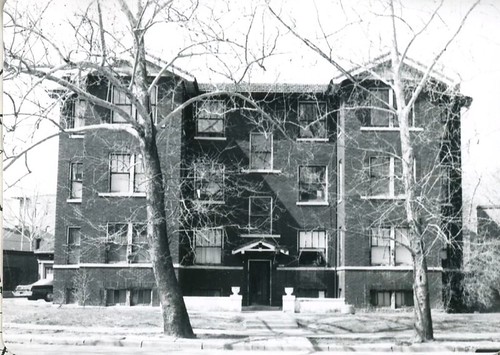 The last of the four pre-war buildings is this arts & crafts style 6-family at 6236 Enright built by R. E. Jones in 1921. This building is located on the curve as Eastgate and Enright come together and while it is a nice building, it has always like the odd man out due to the loss of historic context west of the building. In the 1960's, the entire Parkview Gardens neighborhood was labeled an Urban Renewal Area, and even in the 1983 architectural survey, the historic buildings were listed as endangered due to this designation.
The last of the four pre-war buildings is this arts & crafts style 6-family at 6236 Enright built by R. E. Jones in 1921. This building is located on the curve as Eastgate and Enright come together and while it is a nice building, it has always like the odd man out due to the loss of historic context west of the building. In the 1960's, the entire Parkview Gardens neighborhood was labeled an Urban Renewal Area, and even in the 1983 architectural survey, the historic buildings were listed as endangered due to this designation.
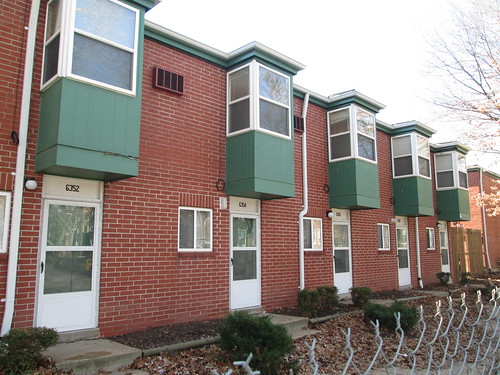 One of the only large scale clearance and redevelopment projects that occurred as a result of the urban renewal designation was the construction of the University Terrace Apartments on Enright. Fourteen original buildings from the 1920's were cleared on the south side of the 62 and 6300 blocks of Enright to make way for the modern apartments. One of the demolished buildings at 6254 Enright was the home of Tennessee Williams during the time he was a student at University City High School from 1926 to 1930.
One of the only large scale clearance and redevelopment projects that occurred as a result of the urban renewal designation was the construction of the University Terrace Apartments on Enright. Fourteen original buildings from the 1920's were cleared on the south side of the 62 and 6300 blocks of Enright to make way for the modern apartments. One of the demolished buildings at 6254 Enright was the home of Tennessee Williams during the time he was a student at University City High School from 1926 to 1930.
The design of the apartments by Anselevicius & Montgomery was chosen in a competition sponsored by HUD. George Anselevicius was a professor at the Washington University School of Architecture, and would later become dean of the school. Most are rows of two story townhomes with the exception of a four story block at Enright and Westgate.
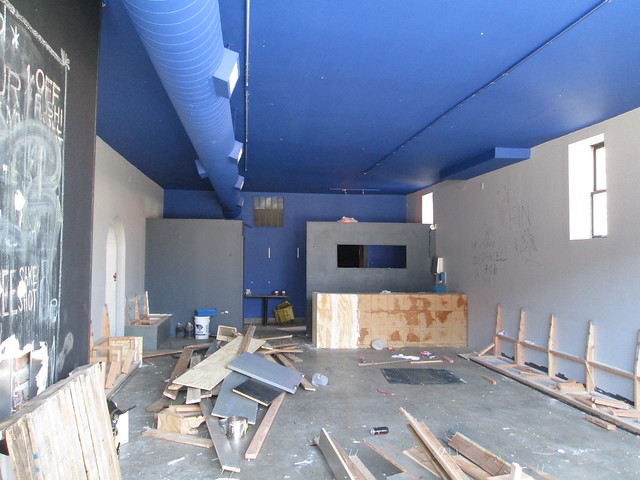 When I went to photograph the buildings that are coming down recently, I happened to run into Eric Schwartz, who recently founded Refab, which is a local nonprofit organization that promotes sustainability and re-use of our built environment by salvaging usable materials from buildings slated for demolition. Refab's first contract is the buildings slated for demolition for Loop Living.
When I went to photograph the buildings that are coming down recently, I happened to run into Eric Schwartz, who recently founded Refab, which is a local nonprofit organization that promotes sustainability and re-use of our built environment by salvaging usable materials from buildings slated for demolition. Refab's first contract is the buildings slated for demolition for Loop Living.
 Eric and his crew were hard at work removing everything that can conceivably be re-used from the buildings. I got a chance to take a look inside, and they have stripped these units bare, including all the hardwood flooring. So while we are losing these buildings, at least it is being done in a sustainable manner.
Eric and his crew were hard at work removing everything that can conceivably be re-used from the buildings. I got a chance to take a look inside, and they have stripped these units bare, including all the hardwood flooring. So while we are losing these buildings, at least it is being done in a sustainable manner.
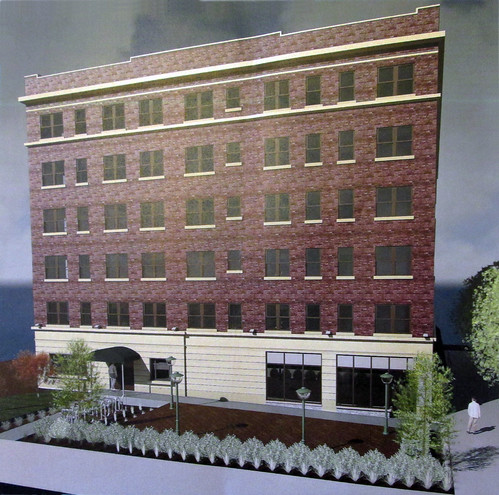 Speaking of sustainability, just around the corner on Skinker at McPherson, Wash U is going for a building permit this week for the complete rehabilitation of the Parkview Apartments. The historic six-story structure built in 1923 was designed by Edward F. Nolte, who was the architect of the building that houses Blueberry Hill, the Lambskin Masonic Temple on Kingshighway and several Craftsman style homes and apartments in the Skinker DeBaliviere neighborhood. Washington University initially planned to begin the renovation last year, but the construction budget was higher than anticipated.
Speaking of sustainability, just around the corner on Skinker at McPherson, Wash U is going for a building permit this week for the complete rehabilitation of the Parkview Apartments. The historic six-story structure built in 1923 was designed by Edward F. Nolte, who was the architect of the building that houses Blueberry Hill, the Lambskin Masonic Temple on Kingshighway and several Craftsman style homes and apartments in the Skinker DeBaliviere neighborhood. Washington University initially planned to begin the renovation last year, but the construction budget was higher than anticipated.
So what did they do? They formed a for-profit entity and will be getting state and federal historic rehabilitation tax credits in order make the project financially more feasible. This is an example that a certain other local university should look into for a certain building at the corner of Grand and Chouteau!
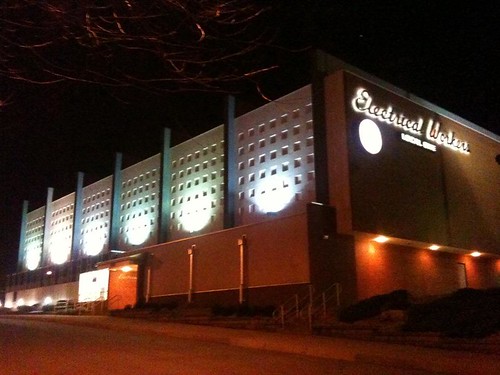 What are your favorite Mid-Century Modern buildings in St. Louis? If you missed the public meeting last night for the Mid-Century Modern architectural survey that the St. Louis Cultural Resources Office is currently conducting, you can still comment on the proposed list of buildings for further study, which will be narrowed to 25-30. To view and comment on the 40 properties under consideration, including the IBEW Hall pictured above, visit the CRO's Modern Architecture in St. Louis page. If there is an MCM gem that you don't see on the list but feel should be, include this in your comments. Note that MCM buildings that are already listed on the National Register are not included in this survey. Please email your comment forms by end of day Thursday to CRO Director Betsy Bradley: bradleyb@stlouis-mo.gov
What are your favorite Mid-Century Modern buildings in St. Louis? If you missed the public meeting last night for the Mid-Century Modern architectural survey that the St. Louis Cultural Resources Office is currently conducting, you can still comment on the proposed list of buildings for further study, which will be narrowed to 25-30. To view and comment on the 40 properties under consideration, including the IBEW Hall pictured above, visit the CRO's Modern Architecture in St. Louis page. If there is an MCM gem that you don't see on the list but feel should be, include this in your comments. Note that MCM buildings that are already listed on the National Register are not included in this survey. Please email your comment forms by end of day Thursday to CRO Director Betsy Bradley: bradleyb@stlouis-mo.gov
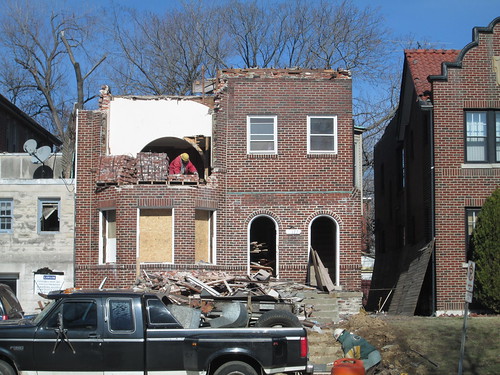 Demolition is a relatively rare occurrence in Skinker DeBaliviere, but this week a two-family building at 6177 Waterman is slowly disappearing.
Demolition is a relatively rare occurrence in Skinker DeBaliviere, but this week a two-family building at 6177 Waterman is slowly disappearing.
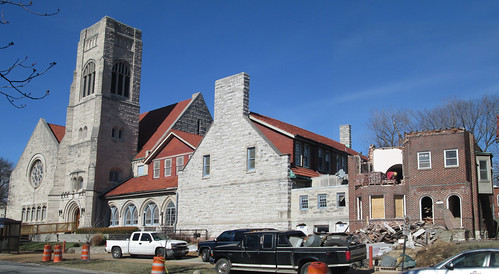 The building was for many years the parsonage for Grace United Methodist Church Which is located at Skinker and Waterman. The church was designed by a short-lived partnership of Theodore C. Link, Alfred Rosenheim & William B. Ittner. The building was originally constructed on Lindell Boulevard at Newstead, directly across from the New Cathedral (now the site of the Town House apartments). A chapel was built first in 1892, then the main church which was dedicated in 1897.
The building was for many years the parsonage for Grace United Methodist Church Which is located at Skinker and Waterman. The church was designed by a short-lived partnership of Theodore C. Link, Alfred Rosenheim & William B. Ittner. The building was originally constructed on Lindell Boulevard at Newstead, directly across from the New Cathedral (now the site of the Town House apartments). A chapel was built first in 1892, then the main church which was dedicated in 1897.
In 1913, due in large to westward migration of congregants and the donation of land, the decision was made to move to Skinker. Instead of building a totally new building, they deconstructed the building stone by stone and re-built it in a mirror image of the original! Sometime in the mid-20th century, a small addition connected the church complex to the parsonage. The St. Louis Chamber Chorus has a page with additional history about Grace UMC.
 The decision to take down the parsonage is part of a larger renovation and re-configuring of spaces inside the church which were underutilized as well as create needed gathering space, better vertical circulation and a new entrance for accessible drop-off. The parsonage had not been used as a residence for many years and being built separately from the church, the floors did not align at all.
The decision to take down the parsonage is part of a larger renovation and re-configuring of spaces inside the church which were underutilized as well as create needed gathering space, better vertical circulation and a new entrance for accessible drop-off. The parsonage had not been used as a residence for many years and being built separately from the church, the floors did not align at all.
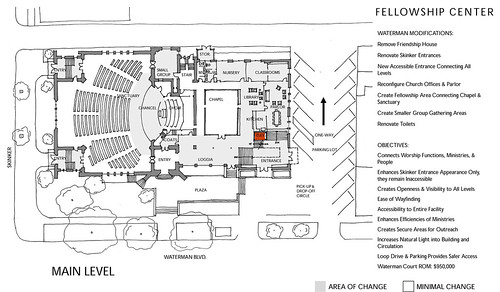 Another part of the program for the renovations was to provide some closer parking for elderly congregants who are currently shuttled in a golf cart to and from a parking lot a block north that is shared with a large apartment building owned by Washington University. Currently there is a small drop-off circle drive with a few accessible spaces.
Another part of the program for the renovations was to provide some closer parking for elderly congregants who are currently shuttled in a golf cart to and from a parking lot a block north that is shared with a large apartment building owned by Washington University. Currently there is a small drop-off circle drive with a few accessible spaces.
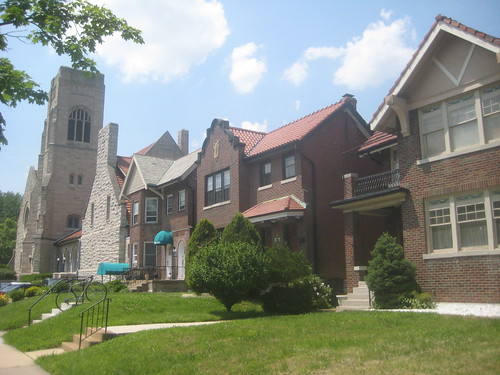 A view of the relation of the church, the parsonage (with teal dome awning) and the streetscape of buildings eastward.
A view of the relation of the church, the parsonage (with teal dome awning) and the streetscape of buildings eastward.
 A rendering above from HKW Architects show how the east end of the church will look with the parsonage and connector addition removed. One of the items brought up by the architect during a presentation about the changes is that removal of the addition would restore the original structure and give unobstructed views of it as it was when originally constructed on Lindell. A Sanborn map of the original church location confirms this notion with the exception of a carriage house on the west portion of the property across the alley.
A rendering above from HKW Architects show how the east end of the church will look with the parsonage and connector addition removed. One of the items brought up by the architect during a presentation about the changes is that removal of the addition would restore the original structure and give unobstructed views of it as it was when originally constructed on Lindell. A Sanborn map of the original church location confirms this notion with the exception of a carriage house on the west portion of the property across the alley.
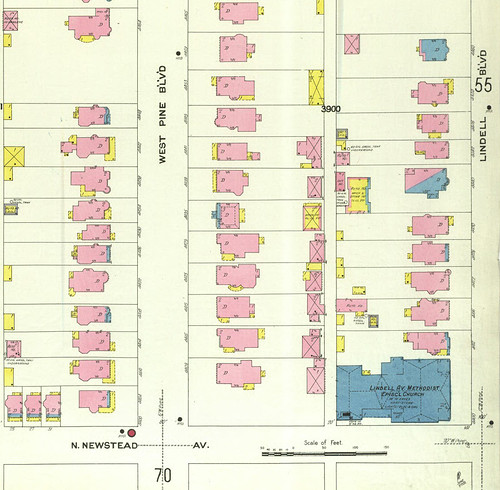
 A close study of the the parsonage building and the two-family building directly east (pictured below) reveals that they are really the same building with two different facades. Built of the same brick, both have the double entrance with similar doors and a projecting two-story element with decorative roof feature. The outline of what had been a roof over the porch similar to the building below is visible behind the teal awning. Checking the City's property records on Geo St. Louis confirmed that the two buildings were both built in 1923.
A close study of the the parsonage building and the two-family building directly east (pictured below) reveals that they are really the same building with two different facades. Built of the same brick, both have the double entrance with similar doors and a projecting two-story element with decorative roof feature. The outline of what had been a roof over the porch similar to the building below is visible behind the teal awning. Checking the City's property records on Geo St. Louis confirmed that the two buildings were both built in 1923.
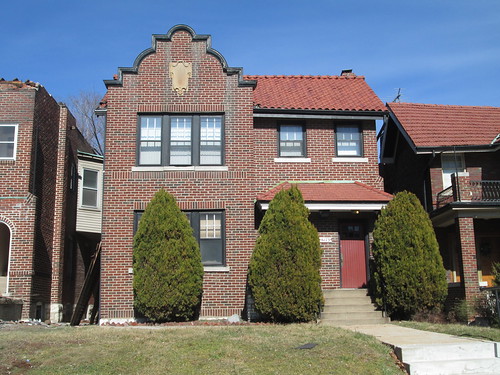 The demolition of this building was reviewed and ultimately approved by the Skinker DeBaliviere Historic District Committee of which I am a member prior to going to official approval from the City's Cultural Resources Office. In exchange for the demolition, I preferred demanding screening of the additional parking with a low stone or brick wall and landscaping, which would have reduced the 14 new spaces shown by 1 or 2, but other committee members did no seem to think this necessary. While I was one of a few dissenting votes, I understand Grace's desire to better accommodate its senior members. The issue of preservation versus neighborhood institutional needs was addressed well by Michael Allen in his recent post about the impending closure os St. Elizabeth Academy.
The demolition of this building was reviewed and ultimately approved by the Skinker DeBaliviere Historic District Committee of which I am a member prior to going to official approval from the City's Cultural Resources Office. In exchange for the demolition, I preferred demanding screening of the additional parking with a low stone or brick wall and landscaping, which would have reduced the 14 new spaces shown by 1 or 2, but other committee members did no seem to think this necessary. While I was one of a few dissenting votes, I understand Grace's desire to better accommodate its senior members. The issue of preservation versus neighborhood institutional needs was addressed well by Michael Allen in his recent post about the impending closure os St. Elizabeth Academy.
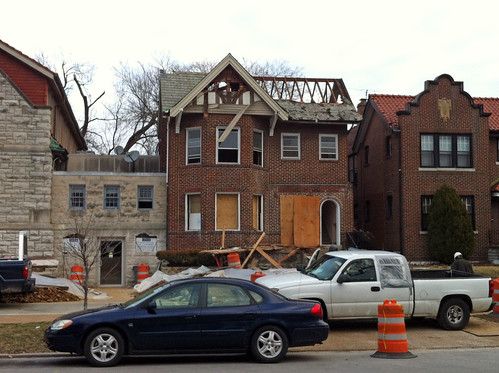 With demolition, the peeling away of vinyl siding reveals the hidden pattern of original half timbering at the gable of 6177 Waterman.
With demolition, the peeling away of vinyl siding reveals the hidden pattern of original half timbering at the gable of 6177 Waterman.
